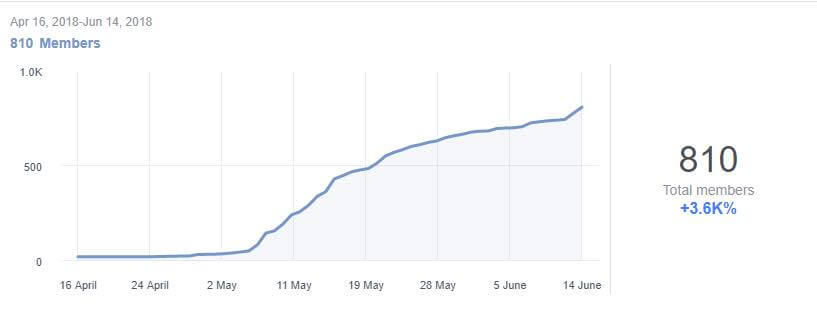Unlocking the Power of Facebook Groups for Business and Personal Growth
Facebook Groups have become an essential tool for businesses, organizations, and individuals looking to build a loyal community, drive engagement, and increase brand awareness. By creating a successful Facebook Group, you can tap into the power of social media to achieve your goals and grow your online presence. In this article, we will explore the benefits of creating a successful Facebook Group and provide guidance on how to create a thriving online community.
One of the primary benefits of creating a Facebook Group is the ability to build a loyal community of like-minded individuals who share similar interests and passions. By creating a Group that resonates with your target audience, you can establish yourself as a thought leader in your industry and build trust with potential customers. Additionally, Facebook Groups provide a platform for driving engagement and encouraging user-generated content, which can help to increase brand awareness and reach a wider audience.
Another benefit of creating a Facebook Group is the ability to increase website traffic and drive sales. By sharing relevant and valuable content with your Group members, you can encourage them to visit your website and learn more about your products or services. Furthermore, Facebook Groups provide a platform for promoting your business and increasing brand visibility, which can help to drive sales and revenue.
So, how do you create a successful Facebook Group? The first step is to define your Group’s purpose and target audience. This will help you to create content that resonates with your audience and establish a clear direction for your Group. Next, you need to set up your Group for success by choosing the right Group type, setting privacy settings, and establishing membership requirements. You also need to create a compelling description and establish rules and guidelines for your Group.
Once you have set up your Group, you need to create engaging content that drives participation and encourages sharing. This can include posting frequency, content variety, and using Facebook’s built-in features, such as polls and quizzes. You also need to build and manage your Group’s membership by promoting your Group, outreach methods, and leveraging existing networks.
By following these steps and creating a successful Facebook Group, you can unlock the power of social media and achieve your business and personal goals. Whether you’re looking to build a loyal community, drive engagement, or increase brand awareness, Facebook Groups provide a powerful platform for achieving success. So, why not get started today and learn how to create a successful Facebook Group?
Creating a successful Facebook Group requires time, effort, and dedication, but the rewards are well worth it. By building a loyal community and driving engagement, you can establish yourself as a thought leader in your industry and increase brand awareness. So, don’t wait any longer, start building your Facebook Group today and learn how to create a thriving online community.
Defining Your Group’s Purpose and Target Audience
When it comes to creating a successful Facebook Group, defining your group’s purpose and target audience is crucial. This will help you to create content that resonates with your audience and establish a clear direction for your group. To identify your niche, start by brainstorming a list of topics related to your business or industry. Then, research your competition and identify gaps in the market that your group can fill.
Once you have identified your niche, create a unique value proposition that sets your group apart from others. This could be a specific benefit that your group offers, such as exclusive content or expert advice. Develop a content strategy that resonates with your audience, including the types of posts, frequency, and tone. Consider using Facebook’s built-in features, such as polls and quizzes, to engage your audience and encourage participation.
Understanding your target audience is also essential for creating a successful Facebook Group. Identify your ideal member by considering demographics, interests, and behaviors. Use Facebook’s targeting options to reach your ideal audience and promote your group to relevant users. By understanding your target audience, you can create content that speaks to their needs and interests, increasing engagement and participation.
When defining your group’s purpose and target audience, consider the following tips:
- Be specific: Clearly define your group’s purpose and target audience to avoid confusion and ensure that your content resonates with your audience.
- Be unique: Create a unique value proposition that sets your group apart from others and provides a specific benefit to your members.
- Be consistent: Develop a content strategy that is consistent with your group’s purpose and target audience, including the types of posts, frequency, and tone.
By defining your group’s purpose and target audience, you can create a successful Facebook Group that attracts and engages your ideal members. Remember to be specific, unique, and consistent in your approach, and use Facebook’s built-in features to promote your group and encourage participation.
Creating a successful Facebook Group requires a deep understanding of your target audience and a clear definition of your group’s purpose. By following these tips and best practices, you can create a thriving online community that drives engagement, increases brand awareness, and achieves your business goals.
Setting Up Your Group for Success: Essential Features and Settings
When setting up a Facebook Group, there are several essential features and settings to consider to ensure success. One of the most important decisions is choosing the right group type. Facebook offers three types of groups: public, closed, and secret. Public groups are visible to anyone and can be joined by anyone. Closed groups are visible to anyone, but membership is restricted to those who are invited or request to join. Secret groups are not visible to anyone except members and can only be joined by invitation.
Another important setting to consider is privacy settings. You can choose to make your group public, closed, or secret, and you can also control who can see your group’s content and who can join. Membership requirements are also important to consider. You can choose to require members to answer questions or provide information before joining, and you can also set up membership approval processes.
Customizing your group’s appearance is also important. You can add a cover photo, profile picture, and description to make your group stand out. Creating a compelling description is also crucial. Your description should clearly state the purpose of your group and what members can expect. Establishing rules and guidelines is also important to maintain a positive and respectful community.
When setting up your group, consider the following tips:
- Choose the right group type: Consider the level of visibility and membership restrictions you want for your group.
- Set clear privacy settings: Control who can see your group’s content and who can join.
- Establish membership requirements: Require members to answer questions or provide information before joining.
- Customize your group’s appearance: Add a cover photo, profile picture, and description to make your group stand out.
- Create a compelling description: Clearly state the purpose of your group and what members can expect.
- Establish rules and guidelines: Maintain a positive and respectful community.
By considering these essential features and settings, you can set up your Facebook Group for success and create a thriving online community. Remember to choose the right group type, set clear privacy settings, establish membership requirements, customize your group’s appearance, create a compelling description, and establish rules and guidelines.
Setting up a successful Facebook Group requires careful consideration of several key features and settings. By following these tips and best practices, you can create a group that attracts and engages your target audience and helps you achieve your business goals.
Content Strategies for Engagement and Growth
Creating engaging content is crucial for driving participation, encouraging sharing, and fostering a sense of community in your Facebook Group. To achieve this, consider the following content strategies:
Posting frequency is essential for maintaining a consistent flow of content and keeping your members engaged. Aim to post at least once a day, but make sure you don’t overpost and flood your members’ newsfeeds. Experiment with different posting schedules to find what works best for your group.
Content variety is also important for keeping your members engaged. Mix up the types of posts you create, including text-only posts, images, videos, and links. Use Facebook’s built-in features, such as polls and quizzes, to encourage participation and drive engagement.
Visual content is particularly effective for driving engagement and encouraging sharing. Use high-quality images and videos to make your posts stand out and capture your members’ attention. Consider creating a content calendar to plan and schedule your posts in advance.
Another effective way to drive engagement is to ask questions and encourage discussion. Ask open-ended questions that encourage your members to share their thoughts and opinions. Respond to comments and messages promptly to foster a sense of community and build relationships with your members.
Finally, consider using Facebook’s built-in features, such as Facebook Live and Facebook Stories, to create engaging and interactive content. These features allow you to connect with your members in real-time and create a sense of urgency and exclusivity.
By incorporating these content strategies into your Facebook Group, you can drive engagement, encourage sharing, and foster a sense of community. Remember to experiment with different content types and posting schedules to find what works best for your group.
Creating engaging content is a key component of building a successful Facebook Group. By using the strategies outlined above, you can drive participation, encourage sharing, and build a loyal community of members who are passionate about your brand or cause.
Building and Managing Your Group’s Membership
Building and managing your Facebook Group’s membership is crucial for creating a thriving online community. To grow your group’s membership, consider the following strategies:
Promotion techniques are essential for attracting new members to your group. Use Facebook’s built-in features, such as the “Invite Friends” feature, to invite people to join your group. You can also share your group’s content on your personal Facebook profile and other social media platforms to attract new members.
Outreach methods are also effective for growing your group’s membership. Reach out to people who have shown interest in your group’s content or niche and invite them to join. You can also partner with other Facebook Groups or influencers in your niche to reach new audiences.
Leveraging existing networks is another effective way to grow your group’s membership. Share your group’s content with your existing networks, such as your email list or other social media platforms, to attract new members.
Managing member requests is also important for maintaining a positive and engaged community. Respond promptly to member requests and messages to show that you value their feedback and participation.
Handling conflicts is also crucial for maintaining a positive group culture. Establish clear rules and guidelines for your group and enforce them consistently to prevent conflicts from arising.
Maintaining a positive group culture is essential for creating a thriving online community. Encourage participation and engagement by recognizing and rewarding members who contribute to the group’s discussions and activities.
By implementing these strategies, you can build and manage a thriving Facebook Group that attracts and engages your target audience. Remember to always follow Facebook’s policies and guidelines when growing and managing your group’s membership.
Building and managing your Facebook Group’s membership requires ongoing effort and attention. By using the strategies outlined above, you can create a thriving online community that drives engagement, encourages sharing, and fosters a sense of community.
Measuring Success and Analyzing Performance
To create a successful Facebook Group, it’s essential to track its performance and analyze the data to make informed decisions. Facebook Insights provides a wealth of information about your group’s activity, including engagement rates, member growth, and content reach. By monitoring these metrics, you can identify areas of improvement and adjust your strategy to optimize results.
Key metrics to monitor include:
- Engagement rate: This measures the percentage of members who interact with your content, including likes, comments, and shares.
- Member growth: Track the number of new members joining your group and the overall growth rate.
- Content reach: Monitor the number of people viewing your posts and the percentage of members who see your content.
- Top-performing content: Identify the types of posts that generate the most engagement and adjust your content strategy accordingly.
In addition to Facebook Insights, consider using third-party analytics tools to gain a deeper understanding of your group’s performance. These tools can provide more detailed information about member demographics, engagement patterns, and content performance.
When analyzing your group’s performance, consider the following best practices:
- Set clear goals and objectives: Establish specific targets for engagement, member growth, and content reach to help guide your analysis.
- Track metrics over time: Monitor your group’s performance over an extended period to identify trends and patterns.
- Use data to inform decisions: Adjust your content strategy, posting schedule, and engagement tactics based on the insights gained from your analysis.
- Experiment and iterate: Continuously test
Measuring Success and Analyzing Performance
To create a successful Facebook Group, it’s essential to track its performance and analyze the data to make informed decisions. Facebook Insights provides a wealth of information about your group’s activity, including engagement rates, member growth, and content reach. By monitoring these metrics, you can identify areas of improvement and adjust your strategy to optimize results.
Key metrics to monitor include:
- Engagement rate: This measures the percentage of members who interact with your content, including likes, comments, and shares.
- Member growth: Track the number of new members joining your group and the overall growth rate.
- Content reach: Monitor the number of people viewing your posts and the percentage of members who see your content.
- Top-performing content: Identify the types of posts that generate the most engagement and adjust your content strategy accordingly.
In addition to Facebook Insights, consider using third-party analytics tools to gain a deeper understanding of your group’s performance. These tools can provide more detailed information about member demographics, engagement patterns, and content performance.
When analyzing your group’s performance, consider the following best practices:
- Set clear goals and objectives: Establish specific targets for engagement, member growth, and content reach to help guide your analysis.
- Track metrics over time: Monitor your group’s performance over an extended period to identify trends and patterns.
- Use data to inform decisions: Adjust your content strategy, posting schedule, and engagement tactics based on the insights gained from your analysis.
- Experiment and iterate: Continuously test new content types, posting frequencies
Measuring Success and Analyzing Performance
To create a successful Facebook Group, it’s essential to track its performance and analyze the data to make informed decisions. Facebook Insights provides a wealth of information about your group’s activity, including engagement rates, member growth, and content reach. By monitoring these metrics, you can identify areas of improvement and adjust your strategy to optimize results.
Key metrics to monitor include:
- Engagement rate: This measures the percentage of members who interact with your content, including likes, comments, and shares.
- Member growth: Track the number of new members joining your group and the overall growth rate.
- Content reach: Monitor the number of people viewing your posts and the percentage of members who see your content.
- Top-performing content: Identify the types of posts that generate the most engagement and adjust your content strategy accordingly.
In addition to Facebook Insights, consider using third-party analytics tools to gain a deeper understanding of your group’s performance. These tools can provide more detailed information about member demographics, engagement patterns, and content performance.
When analyzing your group’s performance, consider the following best practices:
- Set clear goals and objectives: Establish specific targets for engagement, member growth, and content reach to help guide your analysis.
- Track metrics over time: Monitor your group’s performance over an extended period to identify trends and patterns.
- Use data to inform decisions: Adjust your content strategy, posting schedule, and engagement tactics based on the insights gained from your analysis.
- Experiment and iterate: Continuously test new content types, posting frequencies






